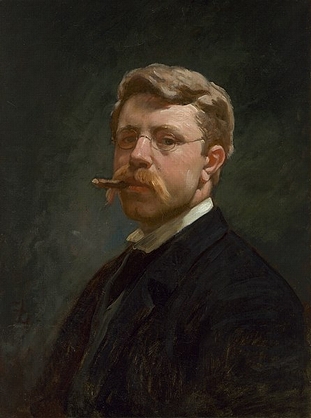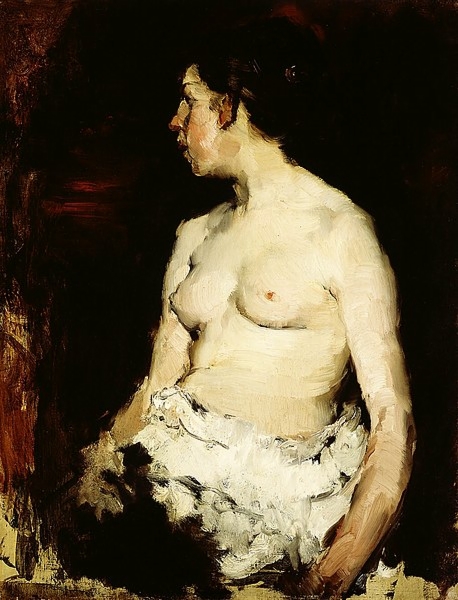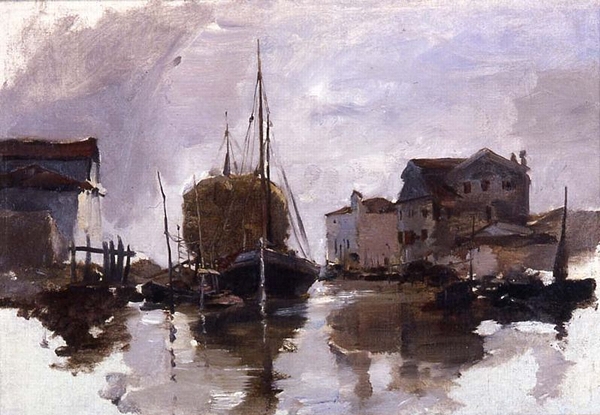
Taft Museum
photo by Tony Walsh
Cincinnati, Ohio
(513) 241-0343
Frank Duveneck (1848-1919): Virtuoso of the Brush
The Cobbler's Apprentice, 1877, oil on canvas, 39 1/2 x 27 7/8 inches, Taft Museum, 1931.415
Frank Duveneck (1848-1919), one of the most influential American expatriate realists of the 19th century and the best known of Cincinnati's painters, will be the focus of a major retrospective exhibition at the Taft Museum this summer. "Frank Duveneck (1848-1919): Virtuoso of the Brush," on view July 16 through October 17, 1999 focuses on Duveneck as the leading figure and guiding spirit of America's Munich School during the 1870s and 1880s. This special exhibition brings together more than 35 of his works, drawn from regional public and private collections.
During the 1870s and 1880s American artists in Munich experimented with a new style of realism featuring dashing brushwork of quickly applied blocks of color, omitting the careful blending of traditional methods. Young boys or older men from working class neighborhoods were among the artists' favorite subjects.
"Duveneck was uniquely suited to this new style, both because of his precocious skill with the brush and his temperament, which was more suited to brilliantly executing a study of a head in a day than to the careful production of a typical academic piece," says guest curator Denny T. Young. "He quickly became a leader among the large number of American students drawn to Munich by its exciting new style and often worked with artists such as William Merritt Chase (1849-1916) and John Henry Twachtman (1853-1902), both of whom would earn reputations as major American artists," she adds.
Typical paintings by Duveneck of this period show a strongly modeled head or figure emerging from a dark, often not fully painted background, with few light or bright highlights. His paint itself is especially oily and has a particularly sumptuous quality. During several summers, Duveneck went to Polling in Bavaria with a group of friends and students to paint en plein air, or out-of-doors. The artist's landscapes produced there exhibit the free brushstrokes of Duveneck's figure studies and an immediacy of response to the light and color of the countryside.
In 1879, Duveneck decided to relocate to Florence, Italy, where his student and later wife, Elizabeth Booth, lived. Many of his students, then known as "Duveneck Boys," followed him to Italy. The artist's style changed dramatically, with dark street urchins replaced by sweet girls in bright sunlight. With Duveneck's broad, vivacious brushstrokes more carefully blended and edited, the paintings of this period lack the masculine force and exuberance of his best work.
During the 1890s Duveneck taught a class a the Art Academy of Cincinnati and later became its chairman. From this time the artist's painting became less important than his legacy as a teacher. He had, however, established himself as an important artist of his period and left a body of work conspicuous for its verve, vitality and quality.
This exhibition is supported in part by Christie's; Fine Arts Fund partner is Procter & Gamble. The official radio partner is Cincinnati's classical public radio, WGUC, 90.9FM.
This article was published 5/30/99 in our Resource Library Magazine
Read more artilces concerning the Taft Museum.
For further biographical information on selected artists cited above please see America's Distinguished Artists, a national registry of historic artists.
Following are images of Frank Duveneck's art for your enjoyment gathered in 2025 from our tfaoi.org website

(above: Frank Duveneck, Siesta, 1886, oil on canvas, 25.5 in x 37.9 in. Cincinnati Art Museum. Bequest of Mary O'Brien Gibson in memory of her parents, Cornelius and Anna Cook O'Brien. Public domain, via Wikimedia Commons)

(above: Frank Duveneck, Self-portrait, c. 1890, oil on canvas, National Portrait Gallery. Public domain, via Wikimedia Commons*)

(above: Frank Duveneck, Seated Nude, c. 1879, oil on canvas, 34 x 26.4 inches, Detroit Institute of Arts, Founders Society Purchase, Robert H. Tannahill Foundation Fund. Public domain, via Wikimedia Commons*)

(above: Frank Duveneck, Harbour Chioggia, Unknown date, oil on canvas, 19.6 x 27.8 inches, Addison Gallery of American Art, Phillips Academy, Andover, MA, bequest of Candace C. Stimson,1944.16. Public domain, via Wikimedia Commons*)

(above: Frank Duveneck, Portrait of Amy Folsom, c.1880, oil on canvas, 35.9 x 24 inches, Montclair Art Museum, Museum purchase; Acquisition Fund, 1962.27. Public domain, via Wikimedia Commons*)
*Tag for expired US copyright of object image:

Links to sources of information outside of our website are provided only as referrals for your further consideration. Please use due diligence in judging the quality of information contained in these and all other web sites. Information from linked sources may be inaccurate or out of date. TFAO neither recommends or endorses these referenced organizations. Although TFAO includes links to other web sites, it takes no responsibility for the content or information contained on those other sites, nor exerts any editorial or other control over them. For more information on evaluating web pages see TFAO's General Resources section in Online Resources for Collectors and Students of Art History.
 Search Resource Library
Search Resource Library
Copyright 2025 Traditional Fine Arts Organization, Inc., an Arizona nonprofit corporation. All rights reserved.